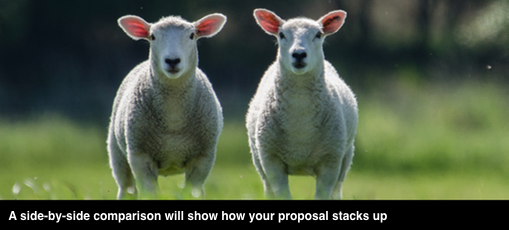A recent post explained how to use Freedom of Information requests to obtain your competitors’ bid proposals. The next step is to compare those proposals against your own to find areas where you can improve.
Since you’ve invested effort in getting the proposal, it’s worth making a careful analysis. Don’t let hard feelings towards the competitor or the evaluators (or your desire to put the loss behind you) turn this opportunity into a superficial exercise. Instead, structure your review to maximize the available learning.
Address questions in four areas
Focus on areas where successful proposals typically shine.
Compliance
Successful proposals typically comply with all requirements. Evaluate for:
- Compliance with key requirements
- Instances where the competitor shows it exceeds minimal requirements
- Devices used to draw evaluators’ attention to compliance, for example, a compliance matrix, icons or callouts
Responsiveness:
How well does the proponent—
- Demonstrate understanding of the prospect’s strategic drivers?
- Acknowledge and address hot button issues?
- Connect the proposed solution to the requirements and issues?
Differentiation:
How well does the proponent find opportunities to express differentiation when—
- Presenting its team, by aligning specific qualifications and experience to the requirements?
- Describing its superior experience and past performance in similar projects?
- Using ghosting, trade-offs and other techniques to position itself against other offers?
Reader engagement:
Assess how well the proponent—
- Uses clear, plain language with a minimum of jargon?
- Supports its performance claims with facts?
- Demonstrates client focus by citing prospect-specific benefits when describing features and processes?
- Aligns proposal structure with the requirements and/or the scoring system?
- Uses layout, type and colour to create an attractive and easy to read proposal?
- Visualizes key features and benefits, using captioned photos, illustrations, charts and graphs?
Review compliance, responsiveness, differentiation and reader engagement separately, rather than trying to assess them in one pass. Also, have team members conduct reviews independently, making notes for each question. Then get together and compare notes.
Finally compare the competitor’s proposal against your own in each area and, if available, to the evaluator’s notes by section.
Consider using a third party
Consider inviting a proposal consultant to help with your review and to facilitate a team session to assess what your team found and evaluate the differences.
An outside expert will see things your team will likely miss. He or she will also ensure a no-blame atmosphere, so the review stays positive.
Decide on next steps
Close the loop by agreeing on next steps. Prioritize your improvement ideas and set reasonable expectations. Build frequent reviews into your management process so you can monitor for improvement on the next proposal.


